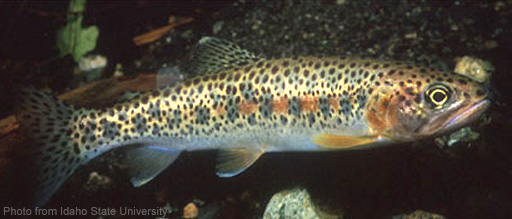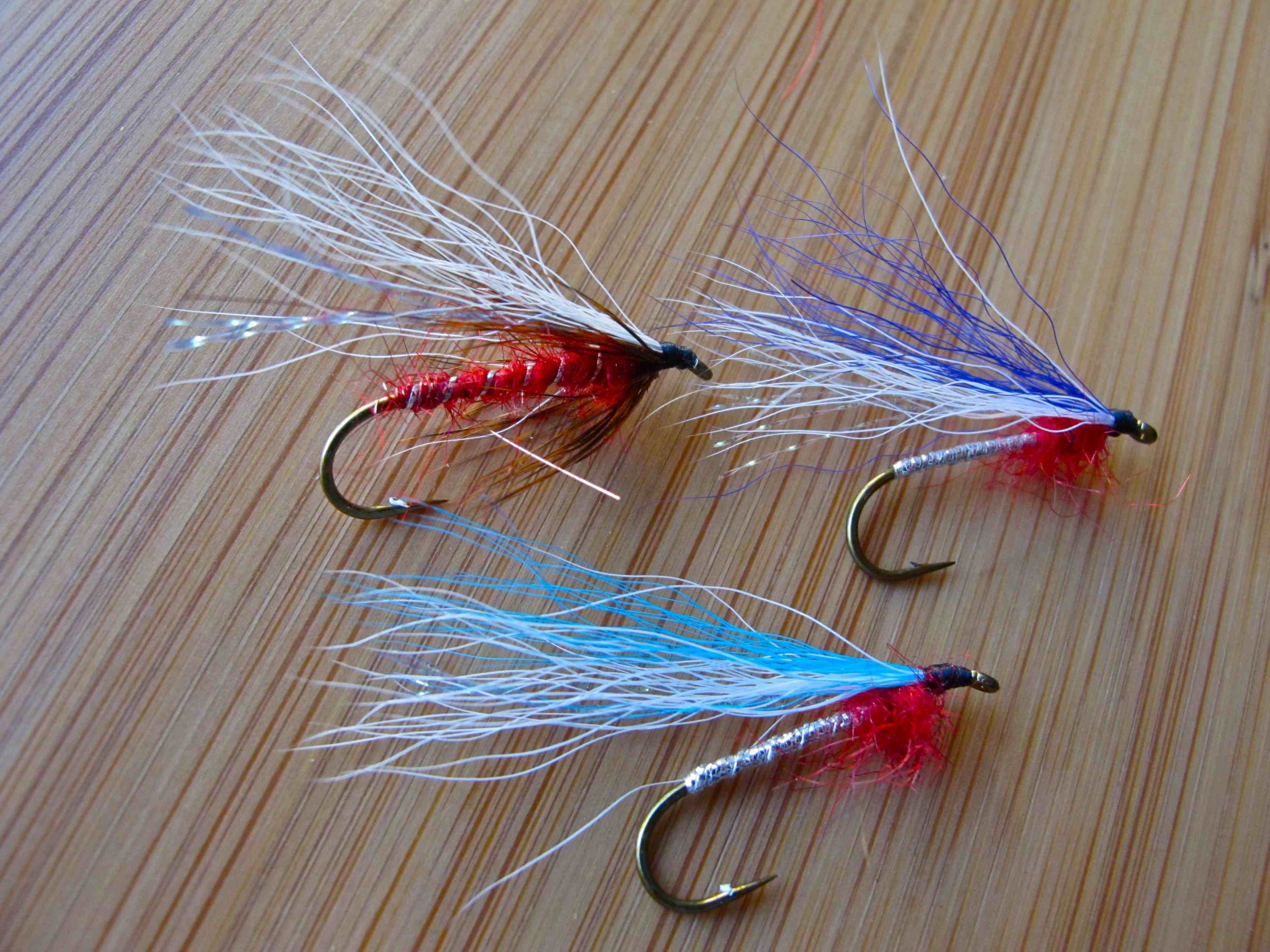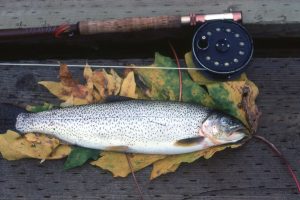Coastal Cutthroat Trout in BC
The coastal cutthroat trout is often termed the “native “trout of the northwest coast because it is so well adapted to the wide range of aquatic environments in this region. Cutthroats occur in nearly all coastal streams from Southeast Alaska to Northern California, from tiny pastoral creeks to large, turbulent rivers. They also occur in the big lakes and most of the little lakes and ponds and they are no strangers to estuaries, beaches and bays along the coast. Wherever they are found, coastal cutthroats are among our most interesting and popular sport fish.
They are handsome fish and are usually not difficult to find or catch in lakes, streams or the sea provided anglers know something about their habits in the area they are fishing, Complex tackle and large boats are seldom required. Just a light rod, some waders and a handful of flies or small spoons and perhaps a small boat.
A Big Qualicum sea – run.
GENERAL DESCRIPTION
Size and coloration depend largely on the home environment. Sea run cutthroat may attain weights of 2 – 2.5 kilograms with the average being closer to .5. Larger sea runs occur but I have never seen one and they are said to be rather rare. Immature fish are green to metallic blue on the dorsal surface and upper flanks. In one area I fish a lot which is well inside a large estuary protected by a barrier beach, fish that stay mostly in the estuary and lower river, are highly colored while outside fish that patrol the beach are silver bright.
As spawning season approaches, they start to take on a lemon yellow to brownish tinge and the characteristic paired slash marks on their lower jaw become a vivid orange or red. Maturing sea runs are often called yellow bellies. Coastal cutthroats are usually more heavily spotted than steelhead, resident rainbows or the Westslope Cutthroat of the Kootenays.
Lake residents vary considerably in size. In large lakes which contain other fish like rainbows, kokanee or sockeye and forage fishes like sticklebacks and sculpins, they grow quite large. Lakes like Cowichan, Sproat, Buttle, Powell and Owikeno can produce some giants. A seventeen pounder was caught in Sproat in 1957. But the cutthroats in the many smaller lakes and ponds seldom attain much size and often over populate the lakes. Like sea runs. Cutthroats in coastal lakes are usually silvery as immature fish but coloration increases with maturity. They often have a pink rainbow like tinge on their flanks. The two species sometimes interbreed in lake tributaries and it is often difficult to tell their offspring apart.
Many coastal streams have cutthroat populations that live out their lives in a few pools in headwater reaches. Conditions are often harsh there and the little trout are hard pressed to attain sizes of 15 – 20 cm. However, the little stream dwellers are among the most beautiful and interesting members of the trout and salmon family.

LIFE HISTORY
Sea run cutthroat are found in nearly all BC coastal rivers but they do best in the small streams. Young cutthroats are shy and non aggressive. When they compete with young steelhead and coho, they avoid conflict by living in less favorable living spaces. Fortunately, there are substantial coastal lowlands laced with small streams ideally suited for cutthroat. These little brooks are often more diverse in habitat and richer in food organisms than the lager creeks frequented by the more territorial salmonids.
A few sea runs begin entering some of the larger rivers with the early pink and sockeye which can start in July. These are not true spawning fish, they are just tagging along to feed on loose eggs or insects stirred up by salmon spawners. A few weeks later, some cutthroats begin to head upstream for their spawning. In many of the smaller creeks, the cuts will not enter until the persistent fall-winter rain fires up which can be as late as December. The spawning period therefore usually last from December to March. These fish are notorious for their lack of attention to calendars. I have seen them in spawning behaviour from November to May.
Most sea run cutthroat spawn after one or two summers in salt water and one to three years in freshwater as juveniles, as spawners they range from two to five years in total age. Smaller streams are usually preferred and the fish seek out a gravel riffle near cover where the female excavates a red with strong tail flexes and males settle in and deposit sperm. Spawning rigours are less than those of steelhead so some cutts survive to spawn again. The fish drift back to the estuary later in the spring to regain their strength.
For the product of their effort, life begins as a pocket of eggs buried in the gravel. Only a small portion survives the perils of winter. Sometime between April and July, the fry begin wiggling up to begin stream life as 25mm fish. They seek out gentle current by the stream margins. Quiet vulnerable now, they have to dodge a host of predators like birds, snakes and larger fish that eagerly wait to dine on small trout. AS the water warms and the food supply increases the little fish gain growth and move into mid stream and try to defend a territory. They prefer to live in pools but if the larger and more aggressive steelhead and coho are present in sufficiently large numbers, they are pushed into less favourable riffle habitat to live, If there is no riffle habitat because of poor stream structure or extremely low summer flows, most young cutthroat are fated to die. In the fall of their first year of stream life, the remaining young cutthroats are from 5-8 cm long.
As fall advances, streams cool and flows begin to rise, the young fish move back to quiet water to seek winter sanctuary. Favoured resting places are side channels, deep pools, log jams, adjacent riparian ponds or wetlands and the undercut roots of streamside vegetation. The small fish do little feeding or even moving around in winter. There is little food to be had and the cold water makes the fish very lethargic. When spring finally arrives the survivors are thin, dark and weak.
Spring is a time of revival in streams and the young trout are quick to regain their strength and vitality in the warming, energy rich water. Fish that seemed barely alive in March are now healthy and active. Some of the more vigorous are able to double their size in the spring and early summer months. In some of the more productive South Coast streams, some fish are now large enough to smolt and head for sea. Most will remain for another year or two.
The larger young trout that remain in the stream, can seek out pools now as their summer habitat. They are now larger than young coho and are free to choose their living space without interference. In many small streams, the riffles are too shallow to support the fish. Some streams even become intermittent in the summer and early fall and the pools provide the only water. The cover and shade provided by streamside vegetation, logs and boulders become important survival factors. When winter returns, the fish again seek out shelter and with the onset of spring, the fish begin to feed ravenously and up their size to 12 – 20 cm. Then, late in April or early in May under the cover of darkness and the murky water of spring freshets, the fish move down to begin a new life in the sea.
When the trout reach saltwater, the trout do not adapt the wanderlust of steelhead and salmon.
Far from it. Hey are content with the bounty of estuaries and the shoals of nearby beaches and bays. They seldom stray far from their home stream – to the delight of anglers – and are happy to dine on the local smorgasbord of small fishes, shrimp, sand worms and larval forms of marine life.
Cutthroats grow rapidly in the ocean environment and at the end of their first ocean summer many have added 8 – 12 cm of length and have grown from 55 to 270 grams. In the fall and early winter, all cutthroats return to their home stream though not all spawn. Some males are sexually mature after their first summer of ocean life but most fish spawn after their second saltwater summer. The reason cutthroats do not grow as large as steelhead and salmon is that most spend only three to five months at sea each year. While they may live longer and spawn more often than steelhead and salmon, they spend a much larger portion of their lives in streams spawning and overwintering – tough times They seem to have a keener instinct for getting on with the job of survival and an ability to make the best of what nature offers them. This has gained them loads of respect among anglers and biologists. Indeed.
Coastal cutthroat in lakes exhibit a somewhat similar life pattern to sea runs. Spawning and early development occur in the tributary streams before the trout move to the lake for faster growth, mature and return to the streams to spawn. Major differences are most young migrate to the lake as yearlings and in larger lakes with a good food supply they may grow much larger. They live longer in the lakes before returning to the streams to spawn.
Surprisingly, cutthroats in lakes have been shown to make lifestyle adjustments when competing salmonids are present, much the same way they do in streams. When rainbows are present in roughly equal numbers, the more aggressive rainbows dominate the surface and upper zone of the lake where they feed on zooplankton and insects and do not grow large a three or four pounder is a prize. Cutthroats are more oriented to the bottom where the food supply is generally much richer and the cutthroats make better growth than their upstairs neighbours. Rainbows are usually only naturally present in the larger lakes. The rainbows that are present in many of the small lakes in populated areas are stocked hatchery fish. Cutthroats are better suited for all lakes but hatcheries have a hard time finding reliable brood stock. Because they key on fish when they grow bigger, some become quite large.
When cutthroats share lakes with Dolly Varden, it’s the Dollies that take the bottom. Dollies are not common in south coast lakes. They are a very cold water fish and the southern lakes may be getting too warm. They are more numerous in north and central coast lakes where glacial runoff keeps waters cold.
When cutthroats have lakes to themselves and good spawning streams are present, they tend to overpopulate and seldom become large.
THE FUTURE
In some ways, cutthroats have become the forgotten fish of the coast. There has been bursts of hope with the implementation of the Salmonid Enhancement Program (SEP) and its public involvement initiative. Fish biologists have long known of the manageability of the small stream environments of the fish. These small streams are often easily improved by such measures as headwater storage, structural improvement of habitat features such as cover and spawning gravel. Because the fish stay close to home in their ocean phase instead of wandering the sea subject to commercial fisheries, cutthroats are more manageable than steelhead or salmon. The SEP public involvement program has spawned a multitude of stewardship groups that have taken on a lot of the management and protection tasks for the small streams.
But the little creeks are also easily subject to harm and as quick as they may be to respond to a helping hand, they can just as soon suffer from careless land use practices. A lot of effort has been spent trying to educate people on the sensitivities of small streams but there are still significant issues where private land development brushes up against a common property resource and people may actually own the stream bottom. The regional stewardship groups are working hard in their communities to make sure people know about the cutthroat creeks and respect their needs.
In the 1970s, I worked for the BC Fish and Wildlife Branch on Vancouver Island out of Nanaimo. One of my colleagues was Gordon Smith, a wildlife technician and Nanaimo native. He often told me about his grandfather who fished the local streams often for “trout” and usually made great catches. This must have been in the 1920s or 30s. Steelhead fishing was practically unheard of. The streams Mr. Smith fished were still in Nanaimo but there were few or no trout left. Cutthroats are disturbingly susceptible to over fishing because they are so easily caught. I have heard of early days anglers catching dozens in a few hours of fishing. Regulations must be extremely conservative. I think only barbless flies should be used and all fish carefully released. It is only by protecting and improving habitat and not killing any, that cutthroats will return to their honoured position as the Native trout of the BC coast.

A selection of sea-run cutthroat flies that imitate small fish. Note that they are not barbless.
Ted Burns
August 11, 2020
Original version published by the BC Fish and Wildlife Branch in 1981 with art work by Jack Grundle and photos by Ron Ptolemy and the BC Provincial Museum.
Tags: A stay near home fish
